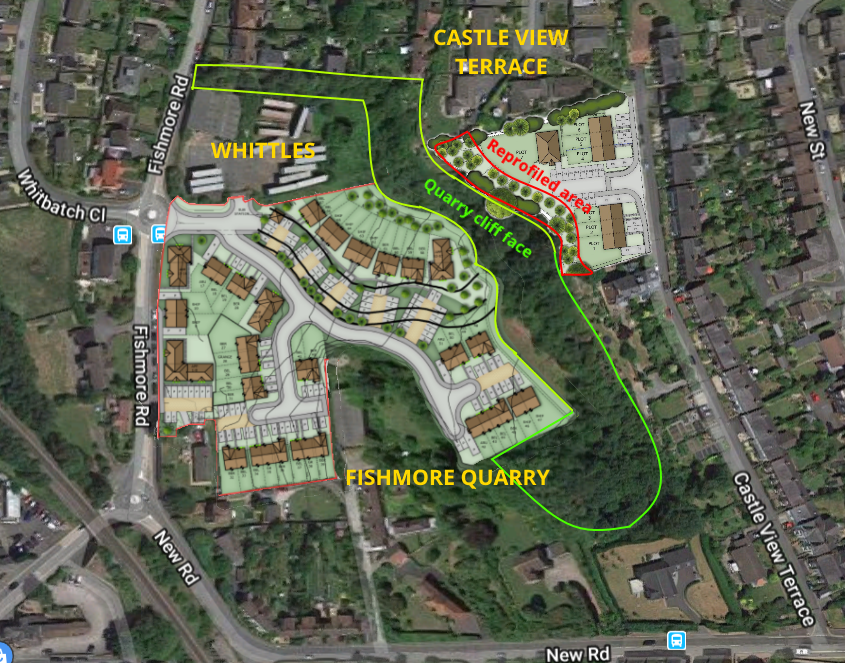Shropshire Homes, already facing massive opposition from residents, has been clarifying its application to build seven homes on Castle View Terrace. At the back of the housing scheme the developer proposes a linear area of public open space. Shropshire Homes this week has explained that it plans to cut three metres off the top of the quarry face, leaving a slope of 45 degrees above an even steeper drop into the quarry.
People will need to negotiate a difficult slope to access the so-called public open space. The proposed profiling of the site will wreck biodiversity on the site.
This scheme never had much credibility. It now has no shred of credibility left.
At its steepest point, the quarry face rises around 12 metres over a distance of 10 metres. That’s steep and it has always been an issue for the Fishmore Quarry development. A retaining fence is planned to prevent residents and houses in the former quarry being hit by slippage from the mudstone quarry face.
This week, Shropshire Homes has clarified its plans for stabilising for the quarry face and the Castle View Terrace scheme. It confirms it will be reprofile the area at the top of the mudstone quarry face, lowering it by three metres. The slope from the quarry to the back of the garden of the proposed bungalow will be 45 degrees. Residents who want to use the so-called public open space will need to negotiate a steep slope. That defies any reasonable definition of accessible open space.
The plans submitted by Shropshire Homes are not as clear as they could be and I will be asking for detailed profiling of the site from Castle View Terrace road to the bottom of the quarry face, a drop of about 20 metres over between 70 and 95 metres. Most of that drop occurs in a shorter distance of between 10 and 30 metres. Obviously, there will be some form of barrier to stop the good citizens of Castle View Terrace tumbling down to Fishmore Road. But the proposed area can hardly be described as public open space.
This area is also described by the developer as part of the environmental network. I get heartily fed up developers who say they will enhance biodiversity by first destroying it.
The scorched earth policy usually involves reprofiling of land and removal of soil. Soils are critical to our ecosystems and it takes decades for a good soil structure and a rich microfauna and microflora to build up. For this development, we will see not only the reprofiling of the quarry face, the soil on the meadow will also be churned and only partly replaced.
Shropshire Homes says present pasture has “no ecological benefits”. Its ecological consultant says the site is of “low ecological value” which is not quite the same. But this highlights a problem we have long had with ecological reports. Our blinkered planning system uses tick box assessments counting bats, trees, the legendary great crested newts, and much else. But ecological reports rarely get to grips with the full richness of biodiversity on a site. They are pro-forma and designed to comply with legislation, not evaluate the richness or otherwise of a landscape facing the bulldozers.
The Fishmore Quarry cliff face had grown a natural covering of self-sown trees and shrubs. Too often planners, developers and councillors assume that rewilding places are inferior to a suburbanised planting scheme. At the Southern Planning Committee last month, councillors discussed the proposed eight homes at Linney House. One councillor argued that the trees on the site were self-seeded and of no great value. But, as the council’s tree officer made clear, what we are seeing is rewilding and that is good for biodiversity.
We should be encouraging rewilding with only minimal, essential intervention. Natural succession is the way nature works. It has also been part of our life on this planet for millennia.
But we are obsessed with scrubbing land bare. With wrecking its ecosystem. Then trying to recreate all that has been destroyed. That takes decades.
We have too great an obsession with trees that look good to the human eye and not enough on the bugs and beasties that crawl and dig around consuming organic stuff before either becoming compost themselves or food supply for bigger beasts.
I will be seeking more information on the proposed reprofiling from planning officers and the developer.
The planning application (20/02971/FUL) is still under consideration by planning officers. There have been 161 objections to this scheme and there is still time to comment.


